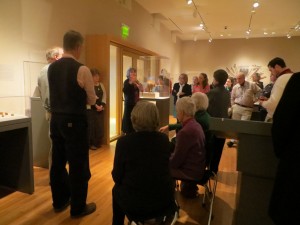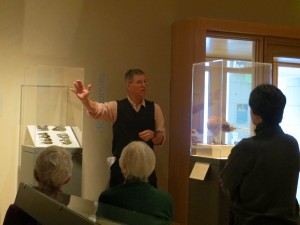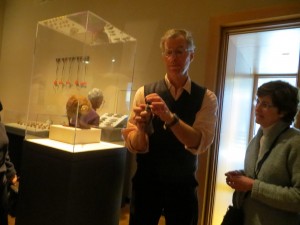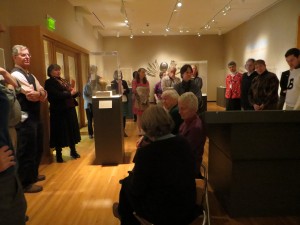
Nathaniel Wheelwright, Anne T. and Robert M. Bass Professor of Natural Sciences, Susan Wegner, Associate Professor of Art History, lead gallery talk in The Object Show
– James Denison ’14, Student Assistant to the Curator
Just a day after a disappointing mid-April snowfall, ornithologist Nat Wheelwright, Anne T. and Robert M. Bass Professor of Natural Sciences, reminded museum-goers that spring was still springing when he announced, quite seriously, that he would be willing to bet anyone in attendance that various warblers would begin to arrive in mid-coast Maine either that day or the next after spending the winter in Middle or South America. This remark was made early on a Thursday afternoon when, as part of the final installation in a series of gallery talks entitled “Multiple Perspectives in The Object Show: Discoveries in Bowdoin Collections,” Professor Wheelwright spoke alongside Associate Professor of Art History Susan Wegner on the stuffed birds featured in the show.

Nathaniel Wheelwright, Anne T. and Robert M. Bass Professor of Natural Sciences leads gallery talk in The Object Show
The Object Show only features a few examples from among the thousands of birds in Bowdoin’s ornithological collection, but among those on view were numerous specimens of chestnut-sided, blackpoll, and black-throated green warblers which will likely soon grace the Bowdoin campus as well. These birds, of the genus Setophaga, developed into different species due to geographic isolation caused by glaciers, leading to the development of over two-dozen species within the taxon. Warblers and other birds have had accidents befall them and been found dead on campus since time immemorial. Many of these individuals have been brought to or collected by ornithology students and professors for stuffing which has led to the formation of our wonderful and diverse collection of birds.

Nathaniel Wheelwright, Anne T. and Robert M. Bass Professor of Natural Sciences leads gallery talk in The Object Show
Professor Wheelwright had begun his remarks by discussing Bowdoin’s kiwi specimen, which was provided to the College by its first Professor of Ornithology, Alfred Gross, sometime after he first came to Bowdoin in the 1910’s. Part of what makes this stuffed kiwi an exciting object is that it is now extremely difficult to import kiwis, dead or otherwise, from their native New Zealand, and so it would be nearly impossible to replace the taxidermied bird we now have on display. Kiwis, who long feared little opposition for environmental supremacy on two islands that once featured no terrestrial mammals, have fallen prey to numerous invasive species that have come to New Zealand in the time since Europeans first arrived there, leading to the strict environmental restrictions which now make them difficult to acquire. The kiwi is most closely related to some of the other flightless birds of Oceania, including the cassowary and the emu, and together these species represent the oldest extant bird lineage. These birds are also notable for a strange quirk in their physiology, namely the location of their nostrils – kiwis are the only birds in the world with nostrils at the tip of their bills rather than the base, an adaptation used when rooting for insects and worms underground.

Nathaniel Wheelwright, Anne T. and Robert M. Bass Professor of Natural Sciences, Susan Wegner, Associate Professor of Art History, lead gallery talk in The Object Show
Professor Wegner described the artistry inherent in the carefully constructed pose of the taxidermied kiwi on display before moving on to discuss the importance of birds in art more generally. She made reference to older artists such as John James Audobon, who presented birds and their habitats in his landmark volume The Birds of America, published in the 1820’s and ‘30’s, before discussing taxidermy in the practices of several well-known contemporary artists. Most popular (and notorious) among these is Damien Hirst, particularly his The Physical Impossibility of Death in the Mind of Someone Living, which features a preserved 14-foot tiger shark. She also mentioned and passed around photos of the work of Thomas Grunfeld, an artist who combines elements of different species into single taxidermied wholes in his Misfit series. The talk concluded with speculation by Professor Wegner and audience members on the motivations underlying the resurgence of interest in taxidermy in contemporary art that is represented in the work of Hirst, Grunfeld, and others.
